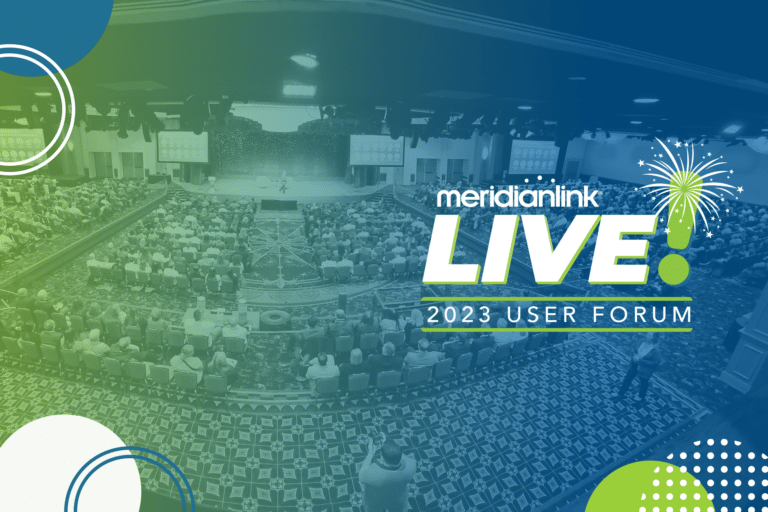The materials available in this article are for informational purposes only and not for the purpose of providing legal advice. You should contact your own advisors with questions regarding the content herein. The opinions expressed in this article are the opinions of the individual author and may not reflect the opinions of MeridianLink, Inc.
In 2022, we met with representatives from two customer credit unions—VP and Director of Loan Operations David Park of Franklin Mint Federal Credit Union (Franklin Mint) and Executive VP Lindsey Laborin of White Sands Federal Credit Union (White Sands)—to take a pulse on the state of delinquencies and collections departments.
One year later, in August 2023, we checked in with these institutions again to see what’s changed. Here’s what we learned:
Delinquencies Are on the Rise
According to recent data from the National Credit Union Administration (NCUA), the delinquency rate at federally insured credit unions was 63 basis points in the second quarter (Q2) of 2023, an increase of 31% compared with Q2 2022; the net charge-off ratio for all federally insured credit unions rose by 24 basis points between Q2 2022 and Q2 2023 for a total of 53 basis points.
Put simply, delinquencies are on the rise, and the collections departments at Franklin Mint and White Sands have felt that increase to varying extents. While White Sands hasn’t seen delinquencies rise to pre-pandemic levels just yet, Franklin Mint is starting to see those numbers return, with both Park and Laborin seeing an uptick in members on the brink of or in delinquency reaching out for help getting back in the black.
Laborin is optimistic that delinquencies may not creep back up to pre-pandemic levels, but she does acknowledge that the return of student loan repayments may negatively impact those delinquency rates. With student loan repayments resuming, income levels and, by extension, the ability to repay delinquencies, could be affected as many people with outstanding student loans believed that debt would be eliminated. Since that didn’t happen, those people are once again saddled with an additional payment each month, which could become the factor that pushes those teetering on the edge of delinquency over into the red.
There’s another big factor that could affect delinquencies, too: continuously increasing interest rates and costs. How? Take for example the higher interest rates on mortgages. A few years ago, people were purchasing homes with significantly lower interest rates, which led to relatively low monthly payments. Now, if those same people need to find extra cash to pay off additional debts they may have accrued, the once-common methods of refinancing a mortgage or taking out equity suddenly may not create as much additional income—or sustained additional income—since those refinances are tied to higher interest rates.
With more limited funds, whether through less-than-stellar refinancing outcomes or a higher cost of living, alongside growing debt or delinquencies, some borrowers are choosing between making a payment or purchasing necessities, like groceries or an electric bill. In fact, for necessities such as electric bills that sometimes have a grace period for late payments, borrowers may opt to take advantage of the grace period and use those available funds to pay down debt. While this may work in the short term, in the long term this can cause borrowers to simply shift the source of their debts.
These issues have driven White Sands to even bring back early-COVID-era policies like “Skip a Payment” and “Hardship” options to help borrowers mitigate difficulties.
Borrower Attitudes & Expectations Are Changing
Laborin mentions an observed tendency among younger borrowers to put off addressing issues such as late payment or repossession marks on their credit scores, perhaps because these borrowers often don’t yet have their eyes on larger purchases—a home, for example—that would require higher credit scores. This attitude presents a challenge to collectors trying to motivate those borrowers to make timely repayments versus taking a hit to their credit scores in exchange for more immediate funds.
Add to that the fact that there’s an increasingly pervasive attitude of self-service when it comes to finance management, and resolving delinquencies becomes even more of an uphill battle for lenders trying to directly contact borrowers with solutions and advice—though in this area, it can also lead to an easier experience for staff and borrowers.
Newer borrowers (who also often tend to be younger borrowers), largely prefer handling banking and collections tasks via technology instead of in-person interactions. For example, Park notes that phone call communications tend to be routed to voicemail—though the borrowers usually return those calls later—while Laborin discusses the successful response rates of first-contact text messages thanks to the method’s less “aggressive” and “formal” perception, in addition to its ease-of-use. While there’s certainly a place for in-person services in collections, there’s definitely a bias for modern, low-touchpoint interactions that help borrowers get what they need in the fewest possible steps.
Navigating These Shifting Attitudes & Circumstances
Between increasing delinquencies and preferences for self-service financial management tools, Franklin Mint and White Sands rely on platforms such as MeridianLink® Collect to help them best serve their members. With automations and features such as soft reminders and pre-delinquency notifications, these credit unions have created the most approachable, convenient user experiences possible, increasing the likelihood of borrowers following through with payments in a timely manner and either getting out of delinquency faster or avoiding it altogether.
Additionally, these functions help staff cut through the less serious issues—such as borrowers who simply forgot to submit a payment with ample funds to do so—to address those who need personalized attention due to extenuating challenges.
MeridianLink Collect’s compliance features have also been a boon to Franklin Mint and White Sands. Collect’s customizable contact criteria ensure staff don’t exceed their set thresholds and overcommunicate or, worse, break compliance regulations. White Sands specifically uses a text integration to further create a streamlined experience with built-in compliance features that prevent staff from texting a borrower if they opt out of text communications—creating less burden on the lender to triple-check opt-outs and contact history. Plus, automations including batch text and email communications further reduce strain on staff by taking those recurring items off their to-do lists.
So, What’s Next?
Park and Laborin both believe that while there’s a silver lining to increasing mortgage rates in that home prices are also up and can provide a substantial source of income, eventually, these bloated values will decrease. Plus, with an all-but-inevitable decrease in housing prices coming at some point in the future, that can put those who do try to refinance their mortgage or take out equity in an even tighter spot when the other shoe finally drops, so to speak. This means that both now and in the future, using mortgage-related options to find extra income for delinquencies is a riskier move.
As mentioned earlier, the resumption of student loan repayments also has the potential to affect delinquencies in the future, though with repayments only just beginning, its impacts won’t be fully understood until a few months or even years in the future.
In short, while delinquencies are rising, it’s too early to determine how much further they will rise over time since several deciding factors in that equation are too early on in play to allow us to come to a definitive answer; however, the factors mentioned above are certainly items to keep tabs on in the coming months.
To learn more about how Franklin Mint and White Sands are tackling delinquencies, how MeridianLink Collect is helping them support borrowers, and what they predict for the future of collections alongside their rationales, watch the full webinar on demand.
Watch the Webinar On Demand







